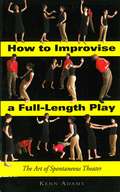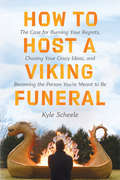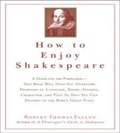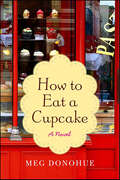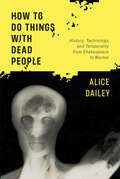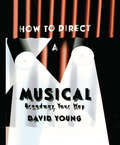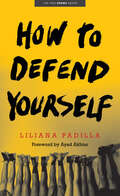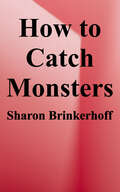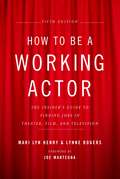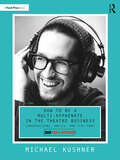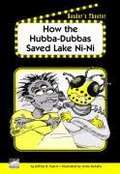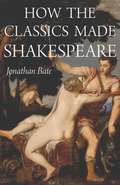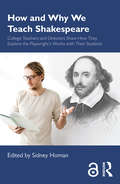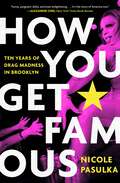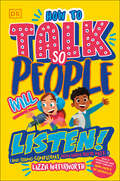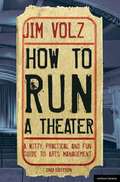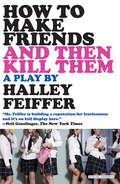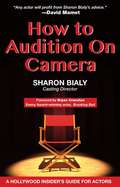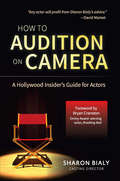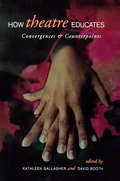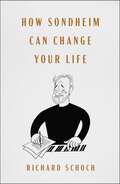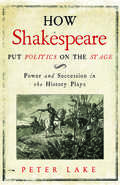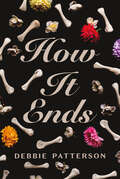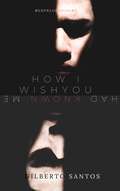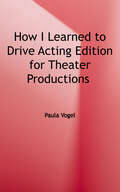- Table View
- List View
How to Improvise a Full-Length Play: The Art of Spontaneous Theater
by Kenn AdamsForget the script and get on the stage! In How to Improvise a Full-Length Play, actors, playwrights, directors, theater-group leaders, and teachers will find everything they need to know to create comedy, tragedy, melodrama, and farce, with no scripts, no scenarios, and no preconceived characters. Author Kenn Adams presents a step-by-step method for long-form improvisation, covering plot structure, storytelling, character development, symbolism, and advanced scene work. Games and exercises throughout the book help actors and directors focus on and succeed with cause-and-effect storytelling, raising the dramatic stakes, creating dramatic conflict, building the dramatic arc, defining characters, creating environments, establishing relationships, and more. How to Improvise a Full-Length Play is the essential tool for anyone who wants to create exceptional theater.
How to Host a Viking Funeral: The Case for Burning Your Regrets, Chasing Your Crazy Ideas, and Becoming the Person You're Meant to Be
by Kyle ScheeleAn inspiring speaker and artist asked 20,000 people around the world to share the regrets they wanted him to burn in a mock Viking ship. This is the story of what he learned about letting go of the pain of the past and embracing the future with hope.Turning 30, artist and speaker Kyle Scheele wanted to do something unusual to mark this milestone. Instead of a birthday bash, he decided to hold a funeral to memorialize the decade of his life that was ending. Building a 16-foot Viking ship out of cardboard, he invited friends to help him set it on fire—a symbolic farewell to his 20s and all the grief, regret, and mistakes that accompanied those years. When video of his Viking funeral went viral, it encouraged many others to let go of past hurts as well. Moved by the response he received, Kyle planned a second funeral (this time with a 30-foot cardboard Viking ship) and asked people to share the things they carried—the bad choices, disappointments, heartaches, and negative thinking that they wanted to lay to rest. He received more than 20,000 responses from around the world—stories both heartbreaking and hilarious, painful and inspiring. In this entertaining and wise book, Kyle reflects on what he discovered about freeing ourselves from the pain of the past, interweaving anecdotes from those who participated with the story of his own journey of renewal. “This story involves multiple Viking funerals, thousands of square feet of cardboard, and enough hot glue to supply your mother-in-law's craft night for the rest of time,” he writes. “But it also involves regret, self-doubt, insecurity, and ultimately, redemption. So buckle up. It's about to get bumpy.”How to Host a Viking Funeral is the story of letting go of the people we used to be, but no longer want to be. It’s about renewal; where there was once regret there is now blank space—an opportunity for a fresh start.
How to Enjoy Shakespeare
by Robert Thomas FallonIn How to Enjoy Shakespeare, the author explores Shakespeare's familiarity in five sections dealing with language, theme, staging, character, and plot, each abundantly illustrated with episodes and quotations from the plays.
How to Eat a Cupcake: A Novel
by Meg Donohue“An irresistible blend of sweet and tart, this book is truly a treat to be savored.”—Beth Kendrick, author of The Bake Off and Second Time Around“A sparkling, witty story about an unlikely, yet redemptive, friendship….Grab one of these for your best friend and read it together—preferably with a plate of Meyer Lemon cupcakes nearby.”—Katie Crouch, bestselling author of Girls in Trucks and Men and DogsAuthor Meg Donohue has cooked up an absolutely scrumptious debut novel, How to Eat a Cupcake, that explores what happens when two childhood friends, Annie and Julia, reconnect as adults and decide to open a cupcakery. But success in their new baking business venture will depend upon their overcoming old betrayals, first loves, and an unexpected and quite dangerous threat. Donohue’s How to Eat a Cupcake is contemporary women’s fiction at its smartest, sweetest, and most satisfying, joining the ranks of The Recipe Club, The School for Essential Ingredients, and Joanne Harris’s classic Chocolat by proving once again that fiction and food make an unbeatable combination.
How to Do Things with Dead People: History, Technology, and Temporality from Shakespeare to Warhol
by Alice DaileyHow to Do Things with Dead People studies human contrivances for representing and relating to the dead. Alice Dailey takes as her principal objects of inquiry Shakespeare's English history plays, describing them as reproductive mechanisms by which living replicas of dead historical figures are regenerated in the present and re-killed. Considering the plays in these terms exposes their affinity with a transhistorical array of technologies for producing, reproducing, and interacting with dead things—technologies such as literary doppelgängers, photography, ventriloquist puppetry, X-ray imaging, glitch art, capital punishment machines, and cloning. By situating Shakespeare's historical drama in this intermedial conversation, Dailey challenges conventional assumptions about what constitutes the context of a work of art and contests foundational models of linear temporality that inform long-standing conceptions of historical periodization and teleological order. Working from an eclectic body of theories, pictures, and machines that transcend time and media, Dailey composes a searching exploration of how the living use the dead to think back and look forward, to rule, to love, to wish and create.
How to Direct a Musical
by David YoungHow to Direct a Musical is a lively and practical guide to the seemingly overwhelming task of directing a musical. David Young brings to this handbook his extensive experience as a director of over 100 productions and more than 250 workshops in the US, China, Senegal and Brazil. Young takes a pragmatic, do-it-yourself approach, guiding the reader from planning to casting, rehearsal to opening night. Topics covered include script analysis, collaboration with designers, musical directors, choreographers and crew, eliminating lengthy pauses between scenes, dress rehearsals and curtain calls.
How to Defend Yourself (Yale Drama Series)
by Liliana PadillaA Yale Drama Series-winning play about self-defense, desire, and healing in the aftermath of a college rape Seven college students gather for a DIY self-defense workshop after a sorority sister is raped. They practice using their bodies as weapons. They wrestle with their desires. They learn the limits of self-defense. This new play by writer, director, actor, and community builder Liliana Padilla explores the intersection of sex, community, and what it means to heal in a violent world. Padilla shows how learning self-defense becomes a channel for these college students&’ rage, anxiety, confusion, trauma, and desire. The play examines what one wants, how to ask for it, and the ways rape culture threatens one&’s body and sense of belonging. It is the thirteenth winner of the Yale Drama Series prize and the second one chosen by Pulitzer Prize–winning playwright Ayad Akhtar.
How to Catch Monsters
by Sharon BrinkerhoffThis book is a wonderful role-play reading adventure! Playbook stories are presented in a unique and colorful format and are read out loud by several readers like a play, without memorization, props, or a stage. <p><p>When you read the book, you and other readers bring the story to life and become the characters. As you read your part out loud, you will have fun expressing and acting like your character. You and the other readers will explore the story plot together and learn what will happen next. It's an exciting journey of discovery that pulls you into the story, and you'll want to read it out loud again and again! <p><p>Begin your reading adventure with the Character Summary at the beginning of the book. You'll notice right away that the words and sentences for each character appear in a different color here and throughout the book. This will make it easy to follow along and read your part with confidence and enthusiasm.
How to Be a Working Actor: The Insider's Guide to Finding Jobs in Theater, Film, and Television
by Mari Lyn Henry Lynne RogersThis comprehensive guide has been revised and expanded to include new information on enhancing your image; finding jobs in emerging markets; updated union rules and payscales; current living expenses; and an entirely new chapter on “Cyberbiz,” exploring the ways that the Internet has opened new doors for actors and enabled entirely new approaches to promotion. Establishing your acting career entails developing all aspects of your performing skills, but more than that, it means learning how to manage your career as an ongoing business. Plenty of schools and books teach you how to hone specific areas of your talent, but onlyHow to Be a Working Actorshows you the whole picture, from improving your image and your audition abilities to finding an agent and landing the roles; from surviving a screen test to making it through your first day on the set; from making your way around the big city to finding regional work. Cowritten by a leading casting director/agent and a seasoned actress/author,How to Be a Working Actoris still the bible of The Biz, with an insider’s viewpoint on all the essentials: assembling a dynamic resume, taking the perfect headshot, understanding the unions, finding a “day job” to supplement your income, learning how to live on a budget in New York or Los Angeles, networking, and much more. Countless tips on wardrobe, makeup, interview skills, and character analysis demonstrate how you can look and act your best for any audition or acting situation. Dozens of industry professionals offer authoritative advice gleaned from decades of experience. Anyone seeking to become—or remain—a working actor needs a copy of this indispensable book.
How to Be a Multi-Hyphenate in the Theatre Business: Conversations, Advice, and Tips from “Dear Multi-Hyphenate”
by Michael KushnerHow to Be a Multi-Hyphenate in the Theatre Business empowers theatre professionals to take hold of their own career and become successful ‘multi-hyphenates’– artists with multiple proficiencies, often cross-pollinating each other to help flourish professional capabilities. Discussing self-identity, networking, workflow, failure, passion, purpose, socially responsible artistry, social media, and the effects of COVID-19, Michael Kushner, award-winning theatre multi-hyphenate artist, sets the stage for artists of all disciplines and backgrounds to find personalized success in the theatre industry. Complete with informative and lively exercises and excerpts from Kushner’s popular podcast and workshop, Dear Multi-Hyphenate, this book addresses questions such as: How do we recover from a pandemic? How do we give more access to marginalized theatre creators? and What goes into producing our own projects? Featuring exclusive information from a myriad of theatre makers such as agents, managers, designers, actors, press representatives, producers, comedians, social media stars, writers, executive directors, CEOs, and lawyers, this book promotes the dismantling of gatekeeping and provides a specialized, hands-on experience to an innovative and lucrative approach to theatre making. How to Be a Multi-Hyphenate in the Theatre Business is an invaluable resource for theatre artists at any level in their careers, whether they are undergraduates, graduate students, professors, award-winning members of the theatre and film community, working professionals, high school students, or entrepreneurs.
How the Hubba-Dubbas Saved Lake Ni-Ni
by Jeffrey Fuerst Anne Flounders Anita DufallaPerform this script about two tribes that must learn to live and work together.
How the Classics Made Shakespeare (E. H. Gombrich Lecture Series #3)
by Jonathan BateFrom one of our most eminent and accessible literary critics, a groundbreaking account of how the Greek and Roman classics forged Shakespeare’s imaginationBen Jonson famously accused Shakespeare of having “small Latin and less Greek.” But he was exaggerating. Shakespeare was steeped in the classics. Shaped by his grammar school education in Roman literature, history, and rhetoric, he moved to London, a city that modeled itself on ancient Rome. He worked in a theatrical profession that had inherited the conventions and forms of classical drama, and he read deeply in Ovid, Virgil, and Seneca. In a book of extraordinary range, acclaimed literary critic and biographer Jonathan Bate, one of the world’s leading authorities on Shakespeare, offers groundbreaking insights into how, perhaps more than any other influence, the classics made Shakespeare the writer he became.Revealing in new depth the influence of Cicero and Horace on Shakespeare and finding new links between him and classical traditions, ranging from myths and magic to monuments and politics, Bate offers striking new readings of a wide array of the plays and poems. At the heart of the book is an argument that Shakespeare’s supreme valuation of the force of imagination was honed by the classical tradition and designed as a defense of poetry and theater in a hostile world of emergent Puritanism.Rounded off with a fascinating account of how Shakespeare became our modern classic and has ended up playing much the same role for us as the Greek and Roman classics did for him, How the Classics Made Shakespeare combines stylistic brilliance, accessibility, and scholarship, demonstrating why Jonathan Bate is one of our most eminent and readable literary critics.
How and Why We Teach Shakespeare: College Teachers and Directors Share How They Explore the Playwright’s Works with Their Students
by Sidney HomanIn How and Why We Teach Shakespeare, 19 distinguished college teachers and directors draw from their personal experiences and share their methods and the reasons why they teach Shakespeare. The collection is divided into four sections: studying the text as a script for performance; exploring Shakespeare by performing; implementing specific techniques for getting into the plays; and working in different classrooms and settings. The contributors offer a rich variety of topics, including: working with cues in Shakespeare, such as line and mid-line endings that lead to questions of interpretation seeing Shakespeare’s stage directions and the Elizabethan playhouse itself as contributing to a play’s meaning using the "gamified" learning model or cue-cards to get into the text thinking of the classroom as a rehearsal playing the Friar to a student’s Juliet in a production of Romeo and Juliet teaching Shakespeare to inner-city students or in a country torn by political and social upheavals. For fellow instructors of Shakespeare, the contributors address their own philosophies of teaching, the relation between scholarship and performance, and—perhaps most of all—why in this age the study of Shakespeare is so important.
How You Get Famous: Ten Years of Drag Madness in Brooklyn
by Nicole PasulkaA madcap adventure through a tight-knit world of drag performers making art and mayhem in the greatest city on earth.Ten years ago, an aimless coat check girl better known today as Merrie Cherry sweet-talked her boss into giving her $100 to host a drag show at a Brooklyn dive bar. Soon, kids like Aja were kicking their way into the scene, sneaking into clubs, pocketing their tips to help mom pay the mortgage, and sharing the stage with electric performers like Thorgy Thor and Sasha Velour. Because suddenly, in the biggest, brightest city in America, drag was offering young, broke, creative queer people a chance at real money—and for thousands or even millions of people to learn their names. In How You Get Famous, journalist Nicole Pasulka joyfully documents the rebirth of the New York drag scene, following a group of iconoclastic performers with undeniable charisma, talent, and a hell of a lot to prove. The result is a sweeping portrait of the 21st-century search for celebrity and community, as well as a chronicle of all the struggles, fights, and disappointments along the way. A rollicking account of the quest to make a living through an art form on the cusp of becoming a cultural phenomenon, How You Get Famous offers an unmissable romp through the gritty and glamorous world of Brooklyn drag.
How To Talk So People Will Listen: And Sound Confident (Even When You’re Not)
by Lizzie WaterworthFind your voice and own the room, even when your legs are shaking!Professional cartoon voice artist Lizzie Waterworth tells you all about her strategies for confident speaking, from breathing exercises to what to do with your hands, and how to conquer that pesky inner voice that whispers "what if...?".Packed with funny stories from Lizzie's world of cartoons, and top tips from a host of professional voice artists and public figures, such as Stephen Fry, David Menkin, and BBC presenter Ben Shires, this book is full of practical advice to help you find your voice!'We teach our children reading and writing but we forget listening and speaking, which are essential life skills. Lizzie brilliantly fills that gap for speaking in this fun, easy to read manual for children of all ages (and parents too!). Every child should have this!' - Julian Treasure, top-10 TED speaker and author of How To Be Heard'The book looks really brilliant - I will definitely be using it for homework sessions with my younger ones.' - Dr Natalie Cawley, counselling psychologist and psychotherapist'Lizzie has a terrific way of helping folks overcome natural fears about speaking in front of others, and this book very much captures her spirit and energy. In How to Talk so People Will Listen, she draws on her professional knowledge and experience to treat the topic seriously while also making it fun.' - James Tierney, Yale University English Language Programs'This book is perfect for helping young ones learn essential skills and grow self-confidence all whilst having fun reading!' - Claudia Dalley, Head of POP Channels'This book is great because it's instructional without being full of jargon...and it's funny too! Definitely one for children and adults even!' - Monique Berry, Headteacher'It&’s like a cartoon on the outside and inside the playfulness continues. I really think this book is an invaluable resource. Although this book is designed for young people, Lizzie&’s advice is applicable to people of any age.' - Ranny Levy, Founder and President, KIDS FIRST! / Coalition for Quality Children's Media
How To Run A Theatre: A Witty, Practical And Fun Guide To Arts Management
by Jim VolzThe first edition of How to Run a Theatre sold out within months of initial publication and it took the cries of the field and pleadings of professors who use the book in their university classes to encourage me to search for a publisher for this second edition. <P><P>Fortunately, publisher Jenny Ridout with London's esteemed Methuen Drama/A & C Black Publishers Limited took time to review the book and take it to her Board. The results are before you - an updated edition with new sections, new contacts and new teaching tools.
How To Make Friends and Then Kill Them: A Play
by Halley FeifferThe uproarious and borderline repulsive play about two neglected sisters and their oddball friend by the author of I’m Gonna Pray For You So Hard. Left to their own devices by their alcoholic mother, Ada and Sam cultivate an insular world into which they soon draw a third wheel – a pockmarked, limping wallflower named Dorrie. In the years spanning childhood to young adulthood, these three troubled girls learn to lean on each other completely, finding ways to fill each other up and to tear each other down. But when a horrible accident turns their reality upside down, they find they must decide whether they will continue to foster their familiar, codependent cycle, or whether they will break free, with or without each other’s aid.
How To Audition On Camera: A Hollywood Insider's Guide for Actors
by Sharon Bialy Bryan CranstonTo win a role in a movie or on network or cable TV, you must make a strong first impression in your brief, crucial audition--and the first person you have to impress is the casting director. In How to Audition On Camera, Casting Director Sharon Bialy answers the twenty-five questions actors ask most frequently about how to nail an audition. What is the casting director looking for? If you mess up, can you start over? What is the most common mistake experienced actors make? Should you audition off book or can you look at the page? Should you dress in character? How much can you improvise? Actors--both novice and professional--are often misled by myths and outdated prescriptions. This guide replaces such misinformation with concise and accurate advice from someone who is in the room helping to make the decision on who gets the job. Bialy gets readers started immediately on the road to screen acting success.
How To Audition On Camera: A Hollywood Insider's Guide for Actors
by Sharon Bialy Bryan CranstonFirst Time in Print Updated and expanded To win a role in a movie or on network or cable TV, you must make a strong first impression in your brief, crucial audition—and the first person you have to impress is the casting director. In How to Audition On Camera, Casting Director Sharon Bialy answers the twenty-five questions actors ask most frequently about how to nail an audition. What is the casting director looking for? If you mess up, can you start over? What is the most common mistake experienced actors make? Should you audition off book or can you look at the page? Should you dress in character? How much can you improvise? Actors—both novice and professional—are often misled by myths and outdated prescriptions. This guide replaces such misinformation with concise and accurate advice from someone who is in the room helping to make the decision on who gets the job. Bialy gets readers started immediately on the road to screen acting success.
How Theatre Educates
by Kathleen Gallagher David BoothCanada boasts a remarkable number of talented theatre artists, scholars, and educators. How Theatre Educates brings together essays and other contributions from members of these diverse communities to advocate for a broader and more inclusive understanding of theatre as an educative force.Organized to reflect the variety of contexts in which professionals are making, researching, and teaching drama, this anthology presents a wide range of articles, essays, reminiscences, songs, poems, plays, and interviews to elucidate the relationship between theatre practice and pedagogy, and to highlight the overriding theme: namely, that keeping 'education' - with its curriculum components of dramatic literature and theatre studies in formal school settings - separate from 'theatre' outside of the classroom, greatly diminishes both enterprises.In this volume, award-winning playwrights, directors, actors, and scholars reflect on the many ways in which those working in theatre studios, school classrooms, and on stages throughout the country are engaged in teaching and learning processes that are particular to the arts and especially genres of theatre. Situating theatre practitioners as actors in a larger socio-cultural enterprise, How Theatre Educates is a fascinating and lively inquiry into pedagogy and practice that will be relevant to teachers and students of drama, educators, artists working in theatre, and the theatre-going public.ContributorsMaja ArdalDavid BoothPatricia CanoDiane FlacksKathleen GallagherJohn GilbertSky GilbertJim GilesLinda GriffithsTomson HighwayJanice HladkiCornelia HooglandAnn-Marie MacDonaldLori McDougallJohn MurrellDomenico PietropaoloWalter PitmanRichard RoseJason ShermanLynn SlotkinLarry SwartzJudith ThompsonGuillermo VerdecchiaBelarie Zatzman
How Sondheim Can Change Your Life
by Richard SchochDiscover the powerful and universal lessons from the music and lyrics of Stephen Sondheim, the genius behind such musical theater masterworks as Company, West Side Story, and Into the Woods.Stephen Sondheim died on November 26, 2021, but for countless fans around the world, he is &“still here,&” to quote one of his lyrics. With acclaimed revivals of his landmark shows occurring around the world and introducing new generations to the man who transformed American musical theater, Sondheim&’s legacy has only grown. What is it about such classic songs as &“Rose&’s Turn&” from Gypsy, &“Send in the Clowns&” from A Little Night Music, and &“Children Will Listen&” from Into the Woods that speaks to us so intimately and profoundly? How Sondheim Can Change Your Life makes the case that Sondheim&’s greatness—beyond the clever lyrics and adventurous music—rests in his ability to tell stories that relate to us all. From Louise&’s desire for freedom as Gypsy Rose Lee to Sweeney Todd&’s thirst for revenge, we as an audience relate easily to Sondheim&’s characters. His works understand us as much as we understand them. Following the arc of Sondheim&’s career, How Sondheim Can Change Your Life is rich with stories about productions and iconic performers, deep readings of his music and lyrics, and insights into his creative process. But more than that, it reveals how Sondheim&’s works can enrich our own lives.
How Shakespeare Put Politics on the Stage: Power and Succession in the History Plays
by Peter LakeA masterful, highly engaging analysis of how Shakespeare's plays intersected with the politics and culture of Elizabethan England With an ageing, childless monarch, lingering divisions due to the Reformation, and the threat of foreign enemies, Shakespeare's England was fraught with unparalleled anxiety and complicated problems. In this monumental work, Peter Lake reveals, more than any previous critic, the extent to which Shakespeare's plays speak to the depth and sophistication of Elizabethan political culture and the Elizabethan imagination. Lake reveals the complex ways in which Shakespeare's major plays engaged with the events of his day, particularly regarding the uncertain royal succession, theological and doctrinal debates, and virtue and virt#65533; in politics. Through his plays, Lake demonstrates, Shakespeare was boldly in conversation with his audience about a range of contemporary issues. This remarkable literary and historical analysis pulls the curtain back on what Shakespeare was really telling his audience and what his plays tell us today about the times in which they were written.
How It Ends
by Debbie PattersonMost of us, when faced with death, wish we could just have a little more time. But what if this is the little more time that we wished for? What are you going to do with it? Grieving siblings Natalie and Bart have differing views on how we die. Natalie, a palliative care nurse, knows how drugs can help ease someone’s pain, and do so on their own terms; Bart, a minister, believes that surrendering to what may come can bring peace and wisdom. Through this immersive show about end-of-life choices, Natalie and Bart are guided by a disabled angel who helps them address their mother’s final decision and understand their own hopes and fears about death. Packed with relatable existential questions, this joyously engaging and reflective play offers a welcoming space to think about what comes next.
How I wish you had known me (DRAMA / Gay & Lesbian #1)
by Gilberto SantosIs it possible to fall in love with someone who's already gone? Lucas and Lauro never met, not in this life... But what would only be an uncompromising holiday trip in the interior of São Paulo turns around the life of Lauro, a psychologist always willing to help. His beliefs are to put to the test amid events that defy logic. After being involved in a mysterious suicide that would hit the small town of Vinhedo, his help to the dead's family would not end as expected; soon Lauro would be involved and in love with Lucas. On the other side, unknowingly, it would also be helping his soul mate to rise spiritually. Follow and be moved by this story, which leaves no doubt that death is just a journey and that soul mates really exist
How I Learned to Drive
by Paula VogelTHE STORY: A wildly funny, surprising and devastating tale of survival as seen through the lens of a troubling relationship between a young girl and an older man. How I Learned to Drive is the story of a woman who learns the rules of the road and l
